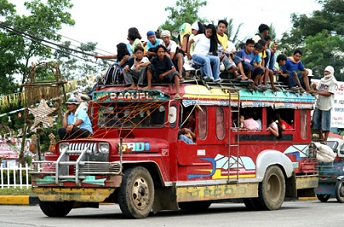Mobile Internet Buses, Vans and Cassrooms to Support Teachers & Learners in Remote Communities


bandwidth can be a challenge
Over the past 15 years, tremendous strides have been made in providing computing equipment and Internet access to schools around the world. Despite this, however, many teachers and students – especially those in rural communities in middle and low-income countries (and occasionally in OECD countries as well) remain largely un-connected.
In response, and as a (presumably, or at least hopefully) temporary stop-gap measure, scores of countries have piloted and championed the use of ‘mobile internet computing facilities’ of various sorts as a way to provide access for learners in remote communities to digital teaching and learning resources through the use of things like ‘internet buses’. For some students, ‘mobile learning’ takes place not with the aid of a smart phone, but rather through monthly visits of Internet-connected buses filled with computers. From Big Blue in Zimbabwe to the Google Internet Bus in India to similar sorts of efforts in countries as diverse as Tunisia, Pakistan, Rwanda, Mauritius, the Philippines, Malaysia, the United States, Canada, Mexico and China, technology-rich portable classrooms on wheels of various sorts are in use – and many more are being considered and planned.
Most efforts of these sorts seem to have been conceptualized and implemented in a vacuum, not informed by related experiences in other places. Even where such efforts help meet objectives that are (if we are honest) more related to politics and public relations than they are to learning, what guidance should the people in charge of such efforts consider in order to get the most out of related investments?
And:
Might there be some related lessons and insights drawn from experience in operating mobile computing learning classrooms that can inform ongoing investments in other areas (school transportation, distance learning, school computer labs, rural Internet access)?
---
Tools and ideas to transform education. Sign up below.
Historically, some of these efforts have grown out of the 'telecentre' movement, with a few notable examples across South Asia (Daknet in India, the 'etuktuk' in Sri Lanka, Telecentre on Wheels in West Bengal) and elsewhere (like the Vasconcelos program in Mexico).
In addition, long-standing initiatives to support bookmobiles (small libraries that travel around in the back of buses or vans) and portable science laboratories are beginning to be adapted to include the use of information and communication technologies in many ways. The Internet Archive Bookmobile is a rather famous reimagining of what a 'bookmobile in the Internet age' might look like, the Nepal Book Bus is another example. In some rural communities around the world, inventive folks have deployed a variety of animals, from camels to donkeys, to transport 'mobile libraries; one effort in Zimbabwe has sought to repurpose this mode of transport in the digital age.
Recognizing that many rural students spend long hours on buses to and from school each day and use this time to do their homework, a number of schools districts across the United States and Canada have been equipping these buses with wi-fi. The rural Coachella school district in California supports perhaps the most well-known effort of this sort; other examples can be found in Minnesota, Arizona and Alberta. In Rwanda, over 400 buses have been connected to 4G Internet, offering passengers (including many schoolchildren) free wireless Internet while taking public transport.
It is perhaps ironic that, when people usually talk about 'mobile education' they are referring to the use of small devices (like phones) that can be carried easily from place to place, but that these devices are in actual practice largely utilized when the user is stationary (sitting, standing, or even lying down). With some high profile analysts have noted that, if we are interested in learning about what's happening at the 'frontier of mobile', we should not be looking to the handset (where innovation, some claim, is slowing, and where a saturation point lies not far off in the horizon) but rather to the automobile. Some activities are taking place at the intersection of these two 'mobile' worlds in education, from transforming a bus into a permanent Internet-connected classroom in the UK to driving and parking a bus that broadcasts a wi-fi signal to houses in a low income communities so that kids can have Internet access at home. Under the Samsung Solar Powered Internet School (SPIS) project, school children in Kenya and South Africa have classes in 40 foot shipping containers that are deposited next to their schools and which feature a number of laptops and Internet connectivity, powered by the sun -- an example of 'mobile Internet classroom' that really only moves once.
Despite the high profile of many such efforts (which can make for irresistible public relations opportunities for politicians and cute stories in the media), however, little is known about them.
- Where are these sorts of initiatives occurring?
- What common circumstances and challenges typically instigate such efforts?
- What are the common deployment models?
- What user groups are being targeted?
- What do such learning environments actually look like?
- Who owns and operates such facilities?
- What does a typical usage schedule (daily, weekly, monthly) for such facilities look like?
- What are typical usage scenarios?
- What technology set-ups are common?
- What are some related emerging good (and bad) practices?
- What do we know about related costs – and benefits?
More fundamentally:
- Do such efforts offer viable, cost-effective approaches to help teachers and students in remote communities take advantage of some of the benefits of educational computing, and/or provide access to specialized equipment related to STEM education?
Or rather:
- Are they in the end just high profile, expensive band-aids that, on a practical level, do little to help reduce the ‘digital divide’?
As a result of the increased attention that the education of transient refugee children is currently receiving, a number of organizations are exploring the use of 'non-traditional' mobile classroom environments, many of which envision the use of information and communication technologies in fundamental ways. As far as I know, no one has (yet) done a rigorous global survey of the use of mobile Internet computer facilities to support teachers and learners in remote communities in an attempt to document and bring together practical information and insights from various efforts that have occured around the world in the past decade or so. Before a number of groups decide to invest lots of money to try to do things like this at a large scale: Maybe someone should?
You may also be interested in the following posts from the EduTech blog:
- How many schools are connected to the Internet?
- Broadband for schools?
- 10 principles to consider when introducing ICTs into remote, low-income educational environments
Note: The image of an overloaded jeepney in the southern Philippines ("bandwidth can be a challenge") comes from the photojournalist and writer Keith Bacongco. Originally uploaded to Flickr, it was found via Wikimedia Commons and is used according to the terms of its Creative Commons Attribution 2.0 Generic license (CC BY 2.0).
cross posted at blogs.worldbank.org/edutech
Michael Trucano is the World Bank's Senior Education & Technology Policy Specialist and Global Lead for Innovation in Education, serving as the organization's focal point on issues at the intersection of technology use and education in middle- and low-income countries and emerging markets around the world. Read more at blogs.worldbank.org/edutech.
